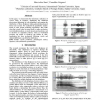Free Online Productivity Tools
i2Speak
i2Symbol
i2OCR
iTex2Img
iWeb2Print
iWeb2Shot
i2Type
iPdf2Split
iPdf2Merge
i2Bopomofo
i2Arabic
i2Style
i2Image
i2PDF
iLatex2Rtf
Sci2ools
102
Voted
INTERSPEECH
2010
2010
Distribution and trichotomic realization of voiced velars in Japanese - an experimental study
In this paper, we demonstrate the trichotomic realization of voiced velars in Japanese, challenging the traditional plosive/nasal dichotomy of velar allophones, and examine the distribution of these allophones taking phonetic/phonological factors into account. We conducted the quantitative analysis based on some speech production experiments. The results show that voiced velars are more likely to realize as plosives in word-initial positions, as nasals in post-nasal positions, and as fricatives in sequential contexts; velars in word-initial positions can realize as fricatives; the decline of velarnasalization has been accelerated; following vowels and dialectal differences can affect the distribution.
| Added | 18 May 2011 |
| Updated | 18 May 2011 |
| Type | Journal |
| Year | 2010 |
| Where | INTERSPEECH |
| Authors | Shin-ichiro Sano, Tomohiko Ooigawa |
Comments (0)

